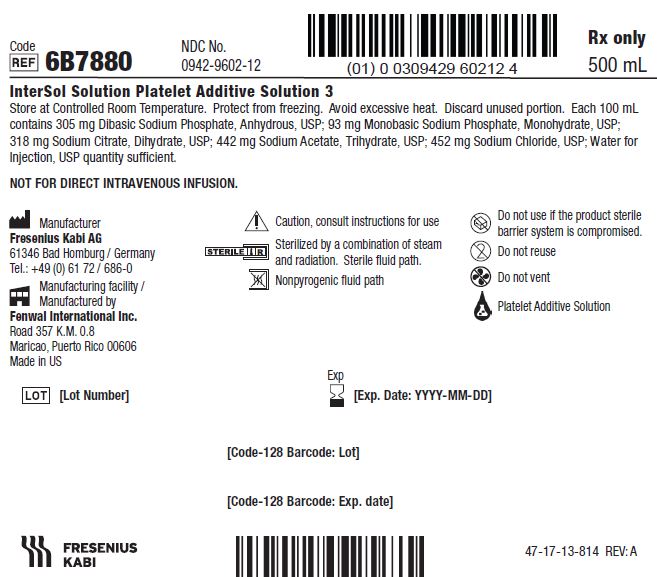Intersol | Platelet Additive 3 Solution while Breastfeeding

What is Intersol | Platelet Additive 3 Solution used for?
What are the risk associated with Intersol | Platelet Additive 3 Solution usage while breastfeeding? What precautions shall I take while using it in breastfeeding?

Intersol | Platelet Additive 3 Solution Breastfeeding Analsys
Sodium chloride while Breastfeeding
SafeCAS Number: 7647-14-5
Sodium chloride either as cooking salt, or, as oral rehydration solution, or, as IV fluid, is entirely compatible with BF.
Sodium acetate while Breastfeeding
SafeCAS Number: 7647-14-5
Sodium chloride either as cooking salt, or, as oral rehydration solution, or, as IV fluid, is entirely compatible with BF.
Anhydrous citric acid while Breastfeeding
SafeCAS Number: 77-92-9
Product that is naturally found in most fruits, especially citrus ones, and which is industrially produced through fermentation of sugar by the fungus Aspergillus niger. It is used in medical compounds as effervescent, to treat intestinal affections, as antioxidant, as an agent for alkalizing urine and dissolution of urinary tract stones. In the food industry it is used as additive (E 330) due to its antioxidant, preservative and flavoring properties. Devoid of toxicity when used at appropriate doses.
Sodium phosphate, dibasic while Breastfeeding
SafeCAS Number: 7558-79-4
Phosphates are used as a laxative and to clean the bowel before medical examinations.They base their action on the little or zero amount which is absorbed (Nice 2000), causing water to escape from the intestine and severe diarrhea.Keep this in mind in order to drink as much as needed and avoid dehydration of the nursing mother who is already producing about 1 litre of liquid in the form of milk a day. Since the last update, we have not found published data on its excretion in breast milk. Both sodium and phosphate are normal components of the body and are found in breast milk at concentrations different to plasma (Allen 1991). Temporary increases in plasma phosphate levels have been observed after the administration of sodium phosphate enema (Salix 2009, Ehrenpreis 2009). It is not known whether this may affect the concentration of phosphate in breast milk, but it is believed that the variation is minimal, temporary and does not have clinical repercussions in the infant. Expert authors consider phosphate-based laxatives compatible with breastfeeding (Nice 2000).
Intersol | Platelet Additive 3 Solution Breastfeeding Analsys - 2
Sodium phosphate, monobasic, monohydrate while Breastfeeding
CAS Number: 7558-79-4; 7558-80-7
Phosphate is a normal constituent of breastmilk. Phosphate concentrations have not been measured in breastmilk after large maternal doses of sodium phosphate, such a 30 gram oral dose for pre-procedural bowel evacuation. However, the added phosphate in breastmilk is likely to be only about 130 mg over 24 hours in this situation. The increase from a typical dose of a rectal enema would be considerably less than this amount. Breastmilk sodium concentration is tightly regulated, and will not be affected. It is probably not necessary to suspend breastfeeding after the use of oral sodium phosphate solutions given once or twice for bowel evacuation before a procedure, but if there is concern, suspension of nursing for 24 hours after a dose should result in negligible increase in phosphate ingestion by the infant. Use of a phosphate rectal enema by a nursing mother would require no special precautions.
Intersol | Platelet Additive 3 Solution Breastfeeding Analsys - 3
Sodium phosphate, monobasic, monohydrate and Breastfeeding
SafeWhat should I do if already breastfed my kid after using Intersol | Platelet Additive 3 Solution?
It is always a good idea to keep your healthcare provider or doctor informed about your drug usage during pregnancy and breastfeeding but if you have not informed your doctor about Intersol | Platelet Additive 3 Solution and have used it then do not panic as Intersol | Platelet Additive 3 Solution is mostly safe in breastfeeding and should not cause any harm to your baby.
I am nursing mother and my doctor has suggested me to use Intersol | Platelet Additive 3 Solution, is it safe?
Definitely, Intersol | Platelet Additive 3 Solution is safe in lactation for baby. No wonder your doctor has recommended it.
If I am using Intersol | Platelet Additive 3 Solution, will my baby need extra monitoring?
No extra baby monitoring required while mother is using Intersol | Platelet Additive 3 Solution
Who can I talk to if I have questions about usage of Intersol | Platelet Additive 3 Solution in breastfeeding?
US
National Womens Health and Breastfeeding Helpline: 800-994-9662 (TDD 888-220-5446) 9 a.m. and 6 p.m. ET, Monday through Friday
UK
National Breastfeeding Helpline: 0300-100-0212 9.30am to 9.30pm, daily
Association of Breastfeeding Mothers: 0300-330-5453
La Leche League: 0345-120-2918
The Breastfeeding Network supporter line in Bengali and Sylheti: 0300-456-2421
National Childbirth Trust (NCT): 0300-330-0700
Australia
National Breastfeeding Helpline: 1800-686-268 24 hours a day, 7 days a week
Canada
Telehealth Ontario for breastfeeding: 1-866-797-0000 24 hours a day, 7 days a week
